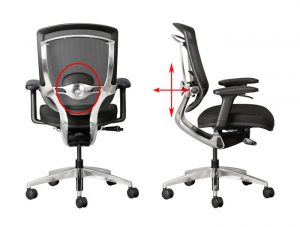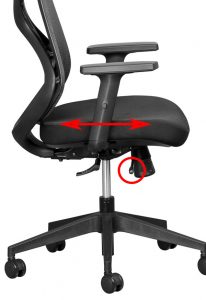- Your cart is empty
- Continue Shopping
Ergonomic and Orthopedic chairs: Features & Differences
Below is a table that shows the important features of typical ERGONOMIC Chair and ORTHOPEDIC chair, and how they differ. There are of course many variations of both chair types, and this table only serves to highlight the major differences.
Features of Ergonomic and Orthopedic Chairs
Adjustable lumbar support
Why is this important?
Chairs with good lumbar support will keep your spine aligned in it’s natural elongated ‘S’ shape. Because our bodies are so varied, chairs with a fixed or pre-defined lumbar support are not suitable for everyone. An adjustable lumbar support and/or height adjustable backrest allows you to position the lumbar cushion to best fit and support the curvature of your spine. Back support for office chairs – why it’s important
Adjustable armrests
A minimum requirement for all ergonomic and orthopedic chairs is height adjustable armrests. Better chairs have multi-adjustable armrests where the pads can be adjusted backwards/forwards, horizontally to change the width of the seat, and finally rotate in/outwards.
Why is this important?
A study done by Rani Lueder (1996), found that an office chair fitted with a height and rotational adjustable armrest, provides superior forearm support during mouse use. The study also found that for keyboard work, armrests reduced fatigue in your neck and shoulders. Dr Alan Hedge (2002) maintains that armrests reduce the static loads on muscles in your neck, back, shoulders and arms. He also states that finger forces are lessened when your arms are supported while typing.
Backrest angle adjustment
Ergonomic chairs have a synchronous (synchro) mechanism that allows you to change the angle of the backrest. The backrest on a synchro mechanism is mechanically linked to the seat, so any change to the backrest angle will simultaneously change the seat angle.
Orthopedic chairs on the other hand, have a Free-Float mechanism that allows you to change the angle of the backrest independently from the seat.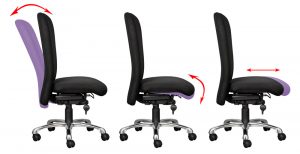
Why is this important?
Sitting statically in a fixed-back chair where the angle between your back and thigh remains constant, is not possible for any extended period of time. Very quickly your core muscles will become tired and cause you to slouch in the chair. Changing the angle of the backrest allows you to position it in your preferred position. Furthermore, constantly changing the backrest angle while you are seated, stimulates the core muscles, thereby increasing the blood flowing through these muscles and preventing them from becoming tired. By doing so, muscle fatigue and it’s associated pain is reduced, particularly in the lower back. This is know as dynamic sitting.
Seat angle adjustment
Ergonomic chairs have a synchronous (synchro) mechanism that allows you to change the angle between the seat and the backrest. The seat on a synchro mechanism is mechanically linked to the backrest, so any change to the seat angle will simultaneously change the backrest angle.
Orthopedic chairs have a Free-Float mechanism that allows you to change the angle of the seat independently from the backrest. In addition, the free-float mechanism allows the seat to be set in a forward-tilt (negative-tilt) position. This is not possible on an ergonomic chair fitted with a synchro mechanism. 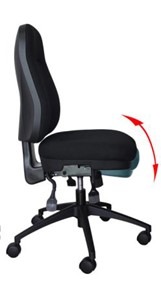
Why is this important?
Adjusting the seat to a forward-tilt position, reduces the rotation of the pelvis when you are seated. By doing so, the natural ‘S’ shaped curvature of the spine is maintained. This decreases the pressure in the lumbar discs, thereby reducing, and in some cases eliminating, chronic lower back pain. According to Occupational Safety and Health Administration (OSHA), a forward sloping seat helps increase blood flow to the lower extremities and at the same time reduces the pressure in the discs of the lower back. What happens when you sit? To prevent you “sliding forward off the seat,” the forward-tilt is typically set at approximately 3 degrees and is limited to a maximum of 5 degrees. This feature is not available on ergonomic chairs fitted with a synchro mechanism. 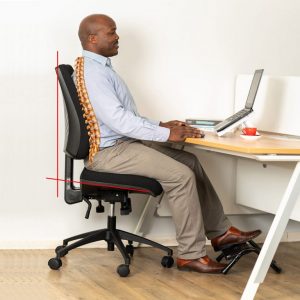
Seat depth adjustment (seat slider)
Why is this important?
When you sit correctly in a chair, there should be a 2-3 finger gap between the front edge of the seat and the back (inside) of your knees. This will ensure the your body weight is evenly spread across the seat of the chair, and so prevent ‘pressure point loading’. If you are above or below average height, a seat-slider allows you to change the depth of the seat. Taller people will want to extend the seat while the converse is true for shorter people. 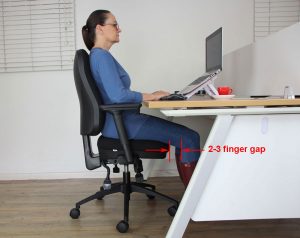
Seat foam
Better ergonomic chairs have a homogeneous moulded foam seat cushion. Cheaper chairs have a block-foam seat cushion that usually deteriorates very quickly and ceases to provide any support for your body.
Orthopedic chairs have a dual-density moulded foam seat that provides superior support for extended periods of time.
Why is this important?
The dual-density seat foam on an orthopedic chair has a firm inner core surrounded by a softer outer foam layer. The combination of these two layers improves your posture and reduces backache and muscle fatigue.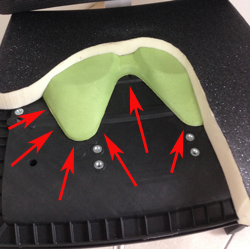
Swivel mechanism
Ergonomic chairs have a synchronous (synchro) mechanism that allows you to change the angle of the backrest and seat. With a synchro mechanism, the movement of the backrest is always greater than the movement of the seat, typically in a 2:1 ratio i.e. the backrest moves 2 degrees for every 1 degree of movement in the seat. 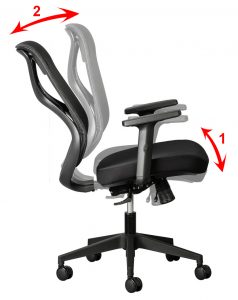
Orthopedic chairs have a Free-Float mechanism that allows you to change the angles of the seat and backrest independently from each other. The free-float mechanism will also allow the seat to be set in a forward-tilt (negative-tilt) position. This is not possible on a chair fitted with a synchro mechanism. 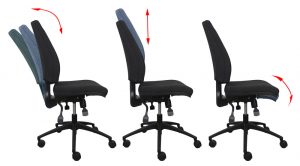
Why is this important?
Unlike with a synchro mechanism, a Free-Float mechanism allows you to independently adjust the backrest and seat of the chair. This enables you to customise the exact angle of the seat and backrest to create your optimal sitting posture. This is an essential feature for anyone with chronic lower back pain that needs to set the chair to suit their unique back ailment.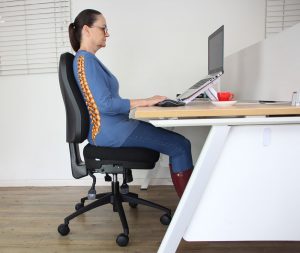 What is the difference between a Synchro and a Free-Float Swivel Mechanism?
What is the difference between a Synchro and a Free-Float Swivel Mechanism?


